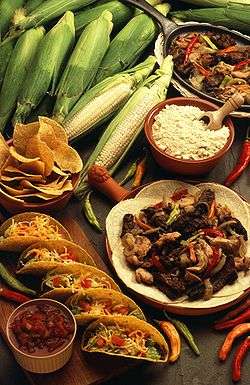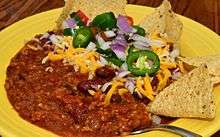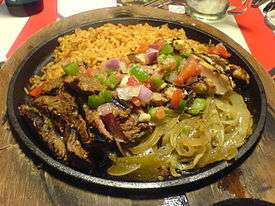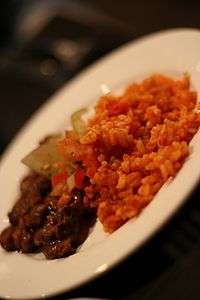Tex-Mex

Tex-Mex (from Texan and Mexican) is a fusion of Mexican and American cuisines, deriving from the culinary creations of the Tejano people living in Texas. It has spread from border states such as Texas and others in the Southwestern United States to the rest of the country as well as Canada. Tex-Mex is most popular in Texas and neighboring areas, especially nearby states in both the US and Mexico.
Tex-Mex is a subtype of Southwestern cuisine[1][2][3] found in Arizona, New Mexico, Nevada, Colorado, and Utah.
Common dishes

Some ingredients are common in Mexican cuisine, but other ingredients not typically used in Mexico are often added. Tex-Mex cuisine is characterized by its heavy use of shredded cheese, meat (particularly beef and pork), beans, peppers and spices, in addition to flour tortillas. Dishes such as Texas-style chili con carne, nachos, hard tacos and fajitas are all Tex-Mex inventions. Moreover, Tex-Mex has imported flavors from other spicy cuisines, such as the use of cumin, introduced by Spanish immigrants to Texas from the Canary Islands and used in Berber cuisine,[4] but used in only a few central Mexican recipes.
History


The word "Tex-Mex" first entered the English language as a nickname for the Texas Mexican Railway, chartered in southern Texas in 1875. In train schedules published in the newspapers of the 19th century the names of railroads were abbreviated. The Missouri Pacific was called the Mo. Pac. and the Texas-Mexican was abbreviated Tex. Mex. In the 1920s, the hyphenated form was used in American newspapers in reference to the railroad and to describe Texans of Mexican ancestry.[5]
In the mission era, Spanish and Mexican cuisines were combined in Texas as in other parts of the northern frontier of New Spain. However, the cuisine that would come to be called Tex-Mex originated with Tejanos (Texans of Mexican descent) as a mix of native Mexican and Spanish foods when Texas was part of New Spain and later Mexico.

From the South Texas region between San Antonio, the Rio Grande Valley and El Paso, this cuisine has had little variation, and from earliest times has always been influenced by the cooking in the neighboring northern states of Mexico.[6] The ranching culture of South Texas and Northern Mexico straddles both sides of the border, where beef, grilled food, and tortillas have been common and popular foods for more than a century.[6] A taste for cabrito (kid goat), barbacoa de cabeza (barbecued beef heads), carne seca (dried beef), and other products of cattle culture is also common on both sides of the Rio Grande.

In the 20th century, Tex-Mex took on such Americanized elements as yellow cheese, as goods from the United States became cheap and readily available.
In much of Texas, the cooking styles on both sides of the U.S.–Mexico border were the same until a period after the U.S. Civil War. With the railroads, American ingredients and cooking appliances became common on the U.S. side.[8]
A 1968 Los Angeles Times feature wrote "[i]f the dish is a combination of Old World cooking, hush-my-mouth Southern cuisine and Tex-Mex, it's from the Texas Hill Country."[9]
In France, Paris's first Tex-Mex restaurant opened in March 1983. After the 1986 release of the film Betty Blue, Tex-Mex cuisine's popularity in Paris increased.[10]
Terminology

The Oxford English Dictionary supplies the first-known uses in print of "Tex-Mex" in reference to food, from a 1963 article in The New York Times Magazine, and a 1966 item in the Great Bend (Kansas) Tribune.[11] Diana Kennedy, an influential food authority, explained the distinctions between Mexican cuisine and Americanized Mexican food in her 1972 book The Cuisines of Mexico. Robb Walsh of the Houston Press said the book "was a breakthrough cookbook, one that could have been written only by a non-Mexican. It unified Mexican cooking by transcending the nation's class divisions and treating the food of the poor with the same respect as the food of the upper classes."[12] The term "Tex-Mex" also saw increasing usage in the Los Angeles Times from the 1970s onward while the Tex-Mex label became a part of U.S. vernacular during the late 1960s, 70s and 80s.[13]
| Part of a series on |
| American cuisine |
|---|
|
Regional cuisines
|
|
Ingredients and foods |
|
Ethnic and cultural |
|
Holidays and festivals |
|
See also
- List of Mexican restaurants
- Cuisine of the United States
- Mexican cuisine
- Tex-Mex cuisine in Houston
- Jane Butel, preeminent author on the cuisine
References
- ↑ Walsh, Robb. The Tex-Mex Cookbook (XVI ed.). New York: Broadway Books.
- ↑ Feniger, Susan; Siegel, Helene; Miliken, Mary Sue (2002). Mexican Cooking for Dummies. Scranton: Courage Books.
- ↑ Martinez, Etienne. "Mexicans in the U.S.A: Mexican-American / Tex-Mex Cousine". Lightmillennium.org. Retrieved 14 October 2017.
- ↑ Jennifer Steinhauer (10 February 2014). "If It's Chili, It's Personal". The New York Times. The Times Company. Retrieved 6 January 2015.
it was Canary Islanders who brought a taste for it in heavy doses, as used in Berber cuisine
- ↑ "Tex-Mex". Mexia Evening News. Mexia, Texas. 23 May 1922.
- 1 2 McCarron, Meghan (7 March 2018). "Everything You Know About Tex-Mex Is Wrong". Eater. Retrieved 2018-06-13.
- ↑ Personal site posting Archived 15 January 2010 at the Wayback Machine.
- ↑ Walsh, Robb (27 July 2000). "Pralines and Pushcarts". Houston Press. Retrieved 11 December 2011.
- ↑ "Pedernales Recipes 'Good for What Ails.'" Los Angeles Times. 12 September 1968. p. K30
- ↑ Walsh, Robb (23 November 2000). "The French Connection". Houstonpress.com. Retrieved 14 October 2017.
- ↑ Oxford English Dictionary entry for Tex-Mex: 1963 N.Y. Times Mag. 11 Aug 50/1 Star of the evening was her Texas or Tex-Mex chili. 1966 Great Bend (Kansas) Daily Tribune 19 Oct 5/4 It's too bad that it has become known as ‘chili powder’ because some homemakers may associate it only with the preparation of ‘Tex-Mex’ dishes.
- ↑ Walsh, Robb (28 September 2000). "Mama's Got a Brand-new Bag". Houstonpress.com. Retrieved 14 October 2017.
- ↑ Wheaton, D.R. & Carroll, G.R. (2017). Where did Tex-Mex Come From? The Divisive Emergence of a Social Category. Research in Organizational Behavior, 37, 143 – 166.
External links
| Wikibooks Cookbook has a recipe/module on |
- "Tex-Mex Foods." Handbook of Texas.
- Robb Walsh's Six-Part History of Tex-Mex in the Houston Press: Pralines and Pushcarts, Combination Plates, Mama's Got a Brand-new Bag, The Authenticity Myth, The French Connection, Brave Nuevo World.
- Temples of Tex-Mex: A Diner's Guide to the State's Oldest Mexican Restaurants
- Lieberman, Dave. "Five Ways To Tell You're Eating Americanized Mexican Food." OC Weekly. Monday 14 June 2010.


.jpg)
